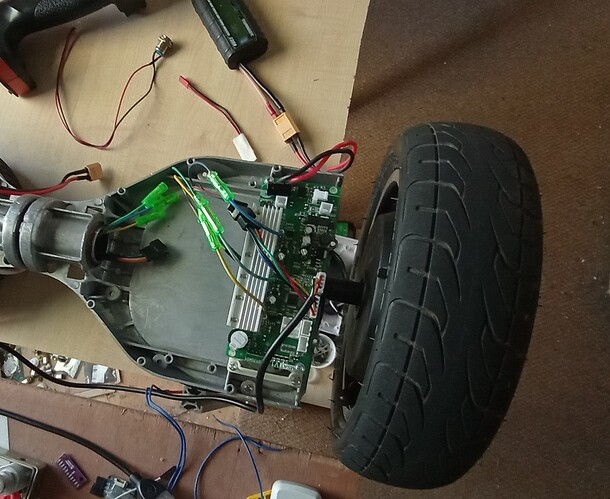I use simplefoc to drive two Hoverboard motors, the motor has a Hall sensor, after the motor stalls then releases the motor, the motor keeps shaking and no longer rotates, how to solve it?
#include <SimpleFOC.h>
#define MOTOR PE8
HardwareSerial SerialMain(PB7, PB6);
BLDCMotor motor1 = BLDCMotor(15);
BLDCMotor motor2 = BLDCMotor(15);
BLDCDriver6PWM driver1 = BLDCDriver6PWM(PA8, PB13, PA9, PB14, PA10, PB15);
BLDCDriver6PWM driver2 = BLDCDriver6PWM(PC6, PA7, PC7, PB0, PC8, PB1);
HallSensor sensor1 = HallSensor(PE2, PE3, PE4, 15);
HallSensor sensor2 = HallSensor(PE13, PE14, PE15, 15);
void doA1(){sensor1.handleA();}
void doB1(){sensor1.handleB();}
void doC1(){sensor1.handleC();}
void doA2(){sensor2.handleA();}
void doB2(){sensor2.handleB();}
void doC2(){sensor2.handleC();}
// velocity set point variable
float target_velocity = 0;
// instantiate the commander
Commander command = Commander(SerialMain);
void doTarget(char* cmd) { command.scalar(&target_velocity, cmd); }
void setup() {
pinMode(MOTOR, OUTPUT);
digitalWrite(MOTOR, LOW);
sensor1.pullup = Pullup::USE_EXTERN;
sensor2.pullup = Pullup::USE_EXTERN;
sensor1.init();
sensor2.init();
sensor1.enableInterrupts(doA1, doB1, doC1);
sensor2.enableInterrupts(doA2, doB2, doC2);
motor1.linkSensor(&sensor1);
motor2.linkSensor(&sensor2);
driver1.voltage_power_supply = 36;
driver2.voltage_power_supply = 36;
driver1.init();
driver2.init();
motor1.linkDriver(&driver1);
motor2.linkDriver(&driver2);
motor1.voltage_sensor_align = 3;
motor2.voltage_sensor_align = 3;
motor1.controller = MotionControlType::velocity;
motor2.controller = MotionControlType::velocity;
motor1.PID_velocity.P = 0.2f;
motor1.PID_velocity.I = 2;
motor1.PID_velocity.D = 0;
motor1.voltage_limit = 18;
motor1.PID_velocity.output_ramp = 1000;
motor1.LPF_velocity.Tf = 0.01f;
motor2.PID_velocity.P = 0.2f;
motor2.PID_velocity.I = 2;
motor2.PID_velocity.D = 0;
motor2.voltage_limit = 18;
motor2.PID_velocity.output_ramp = 1000;
motor2.LPF_velocity.Tf = 0.01f;
// use monitoring with serial
SerialMain.begin(115200);
// comment out if not needed
// motor.useMonitoring(SerialMain);
// initialize motor
motor1.init();
motor2.init();
// align sensor and start FOC
motor1.initFOC();
motor2.initFOC();
// add target command T
command.add('T', doTarget, "target voltage");
SerialMain.println(F("Motor ready."));
SerialMain.println(F("Set the target velocity using serial terminal:"));
_delay(1000);
}
void loop() {
// main FOC algorithm function
// the faster you run this function the better
// Arduino UNO loop ~1kHz
// Bluepill loop ~10kHz
motor1.loopFOC();
motor2.loopFOC();
// Motion control function
// velocity, position or voltage (defined in motor.controller)
// this function can be run at much lower frequency than loopFOC() function
// You can also use motor.move() and set the motor.target in the code
motor1.move(target_velocity);
motor2.move(target_velocity);
// function intended to be used with serial plotter to monitor motor variables
// significantly slowing the execution down!!!!
// motor.monitor();
// user communication
command.run();
}

